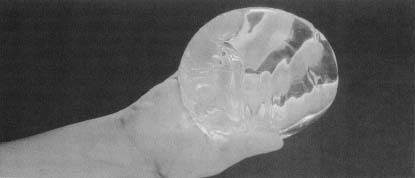Breast implants
Breast implants are designed to either enlarge existing breasts, or to reconstruct breasts after surgery. Until very recently, the vast majority of implants were made of silicone (a generic term referring to organic, or living, compounds resistant to heat, water, and many other elements). Due to recent controversy over silicone implant use, however, many researchers are looking for alternative implant substances.
Two of the "backbones" of silicone are silicon and oxygen. Silicon (a nonmettalic chemical element found abundantly in nature) was first isolated in the 1820s. In the 1880s it was combined with other elements to form useful compounds, including silicone. But it was not until the 1940s that E. G. Rochow of the General Electric Company discovered an easy way to form silicone by combining methyl chloride gas with heated silicon and copper. Silicone was used extensively during World War II (1939-1945) to waterproof sensitive electronic parts, like gaskets for search lights and superchargers for aircraft engines. Medical applications include artificial joints, eye lenses, the Norplant contraceptive (a device implanted under the skin of a woman's arm that slowly releases an artificial hormone), and breast implants.
Silicone was first used in breast implants in the early 1960s. These early implants gave women the option of improving their appearance and the ability to reconstruct breasts that had been removed during cancer surgery. In the past thirty-five years, about one million women have had breast implant surgery. Over time, some of these women have experienced problems or complications. These problems have included localized (limited to a specific area) silicone leakage and hardening of the breast due to tightness of scar tissue surrounding the implant.
In the 1980s, some women who experienced silicone leakage or the more rare rupture (breaking) of an implant began to suspect that silicone was responsible for other health problems, particularly connective tissue diseases such as rheumatoid arthritis (a degenerative disease of the joints). In part due to media coverage in the early 1990s, many women became concerned about the safety of their implants, and the Food and Drug Administration (FDA) began to investigate. The FDA found that proper scientific testing of the implants' long-term effects had not been done. As a result, the FDA banned the use of silicone implants in 1992, pending further test results.
Some women—both individually and as part of "class action" (large group) suits—proceeded to launch a series of legal actions against implant manufacturers, particularly Dow Corning (the major manufacturer of silicone breast implants for many years). The legal controversy has continued, while the scientific community has attempted to conduct studies on the actual effects of silicone in the human body. The tests thus far have not shown a decisive link between silicone and any of the diseases currently associated with its use in implants. Today, breast implants are still available, but most are filled with saline (salt) solution.

Comment about this article, ask questions, or add new information about this topic: